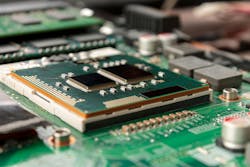How to handle determinism, jitter and load balancing in multicore control architectures
Key Highlights
- Achieving hard determinism in multicore systems typically requires core affinity or asymmetric multiprocessing (AMP) to isolate critical control tasks, while symmetric multiprocessing (SMP) prioritizes efficiency but introduces potential jitter.
- The choice of multicore strategy (core affinity, SMP, AMP, hypervisor or real-time Linux) fundamentally dictates the system's balance between determinism, fault isolation, resource utilization and configuration complexity.
- To effectively deploy modern control systems, engineers must evaluate a platform's multicore capabilities, specifically its handling of task binding and interrupt affinity, to ensure predictable timing when converging real-time control and non-real-time IT workloads.
For many years, real-time control software, whether running on a dedicated controller or an industrial PC, operated on a single CPU core. The runtime scheduler could precisely calculate scan times, and the engineer’s mental model of “one processor, one control loop” held true.
But, as processor architectures evolved, single-core controllers gave way to dual-, quad- and even eight-core designs, and real-time software had to evolve to use those resources effectively. Controls engineers can leverage these extra cores not only for faster computation, but also for greater determinism, system consolidation and flexibility if they understand how their control software manages those cores.
Control platforms now employ a range of multicore strategies. Each balances determinism, flexibility and ease of use differently. The most common approaches include core affinity, symmetric multiprocessing (SMP), asymmetric multiprocessing (AMP), virtualized partitioning and real-time Linux configurations.
Core affinity: deterministic by design
Many real-time runtimes support core affinity, where the user assigns specific real-time tasks or program cycles to designated cores. This provides strong determinism: a high-priority motion or safety loop can execute without interruption from other software activity, while non-critical functions, such as data logging or visualization, run on different cores.
The trade-off is efficiency. If one core is heavily loaded while others are idle, overall CPU utilization suffers. Task-to-core binding also increases setup complexity. For instance, engineers must manually balance load and verify timing margins. However, for systems where predictability outweighs raw throughput, affinity remains the preferred model.
Symmetric multiprocessing: balanced but variable
In an SMP design, the real-time operating system treats all cores equally, scheduling tasks wherever resources are available. This dynamic load balancing simplifies deployment and helps maintain high overall CPU utilization.
The drawback is potential jitter—slight variations in task timing caused by migration between cores, cache misses or interrupt latency. Advanced real-time kernels minimize these effects, but for ultra-tight cycle times, SMP alone may not guarantee hard determinism. Still, for general industrial control and motion applications, SMP offers a good balance between performance and predictability.
Asymmetric multiprocessing: separation for safety and stability
Asymmetric multiprocessing takes the opposite approach. Each core, or group of cores, runs its own instance of an operating system. For example, one dedicated to deterministic control, another to human-machine interface (HMI) tasks and another to analytics or communication functions.
This separation provides excellent fault isolation. A software crash or network spike on a non-real-time core won’t disrupt the control loop running elsewhere. The cost is added design complexity. Developers must explicitly allocate resources and handle inter-core communication through shared memory or messaging interfaces. AMP is often used in mixed-criticality systems, where control and IT workloads share the same hardware but require strict separation.
Get your subscription to Control Design’s daily newsletter.
Virtualized partitioning: the hypervisor approach
When tighter isolation is needed, some multicore controllers employ a “real-time hypervisor.” The hypervisor partitions the CPU cores into secure domains. One domain runs the real-time control kernel, another runs a general-purpose operating system (OS), such as Windows or Linux. This setup enables both environments to operate simultaneously without interfering with one another.
Hypervisors simplify certification for safety-related tasks and allow system consolidation, reducing the number of physical devices on the plant floor. The disadvantages are added overhead and the need for specialized configuration tools. The hypervisor layer itself must also be real-time capable, or it can introduce latency.
Real-time Linux: flexibility meets determinism
An increasingly popular option, especially for edge controllers, is Linux with real-time extensions such as the PREEMPT_RT kernel patch. This approach allows standard Linux software to coexist with time-critical threads scheduled under strict priorities. Engineers can pin real-time tasks to specific cores while general processes share others.
While real-time Linux offers impressive flexibility and a vast ecosystem, it requires careful tuning of interrupt affinities, driver latencies and kernel configuration to achieve consistent timing. It is typically described as “firm” or “soft” real time, suitable for deterministic control with moderate cycle times but not necessarily for the tightest motion loops.
Practical guidance for integrators
When evaluating a control platform’s multicore capabilities, engineers should ask:
- Can specific tasks or threads be bound to individual cores?
- How does the runtime handle interrupt affinity and task migration?
- Are diagnostic tools available to visualize CPU load per core?
- Is the runtime designed for SMP, AMP or hybrid operation?
- Can real-time and non-real-time workloads safely coexist on the same hardware?
The answers reveal how the platform will scale as applications become more data-intensive and computation-heavy. A control strategy that worked well on one core may behave very differently when parallelism is introduced.
The road ahead
As control and IT domains continue to converge, multicore utilization will become a defining performance factor for industrial automation. Future controllers are likely to combine real-time kernels, hypervisors and AI-optimized workloads on shared multicore hardware. The key challenge will be not just faster processing, but maintaining predictable, analyzable timing in a world of ever-greater concurrency. For controls engineers, understanding multicore behavior isn’t just a performance topic; it’s becoming a core competency.
About the Author

Joey Stubbs
contributing editor
Joey Stubbs is a former Navy nuclear technician, holds a BSEE from the University of South Carolina, was a development engineer in the fiber optics industry and is the former head of the EtherCAT Technology group in North America.

